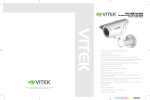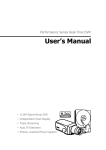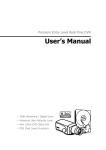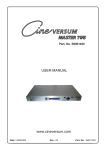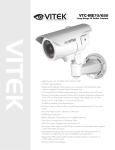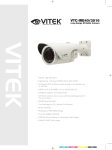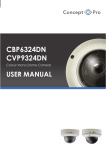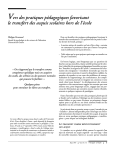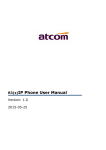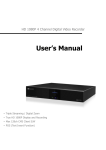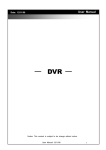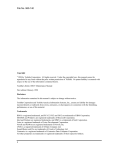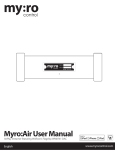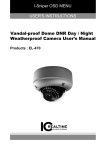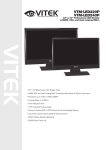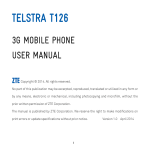Download Chrono-X Manual - PAGES
Transcript
CHRONO X 8 & 16 Channel Real Time D1 Digital Video Recorders VITEK • Real-time D1 recording and playback • 8 or 16 Looping Video Inputs with 1 Main, 4 Spot Monitor Output, 1 VGA and 1 1080P HDMI outputs (1920 x 1080) • H.264 Compression • Supports both Dynamic and Static IP Addresses • 16 (VT-CX1680) / 8 (VT-CX840) Alarm Inputs/Outputs • Up to 480fps Live Display & 480fps Recording (VT-CX1680) / 240/240 (VT-CX840) • Built-in Point-of-Sales support and Multi POS Search • Web Client & CMS (Central Management Software) Included • Free Applications for iPhone, iPad, iTouch and Droid Devices • 500GB to 6TB Internal Storage Options (up to 6TB @ 3x2TB) • Built-in Data Redundancy (Mirror) • Remote Control of additional Chrono–X DVRs locally without the use of a remote PC • System Setup Wizard and User Friendly GUI • Multi-Resolution recording • 4 Selectable Spot Outputs with Sequence and event Pop-up • 16 (VT-CX1680) / 8 (VT-CX840) Audio Inputs & 1 Output • Two Way Audio with Individual Audio Input for each Video Input • Built-in DVD-RW • PTZ Control over RS-485 • Backup via Ethernet or USB Preface We welcome you as a new user of the world's best digital video recorder (DVR), and the leading Digital Video Surveillance System. For effective usage, please read this manual carefully. For future reference, please keep this manual close at hand. Copyright/Authentication/Trademark/Limited Warranty Copyright This manual is produced under copyright law. None of its contents may be copied or duplicated without prior approval. Copyright 2009~ Authentication CE, FCC, KCC Trademark Ethernet(TM) is the trademark of Xerox Corporation. Microsoft(TM), MS-DOS(TM), Windows(TM logo), Windows(TM) and Windows NT(TM) are the trademarks of Microsoft Corporation, used in the United States and elsewhere. Limited Warranty •The manufacturer, importer and agent shall not be responsible for accidental damage (including injury) and other damage caused by inappropriate use or operation of this product. •The information in this manual is prepared based on the current specifications for the product. The manufacturer is currently adding new functions and will continue to upgrade the product with new technology. All specifications may be changed without notice to individual users. Cautions We strongly recommend that users read all safety cautions carefully before operating the product, to operate the product appropriately. Since the indicated cautions contain critical safety information, they must be fully complied with. The cautions are categorized into Danger, Warning, Caution and Important. Risk of death or serious injury. This is the highest priority danger warning. Risk of serious or lesser degree of injury. May also cause damage to the product or to property. Risk of minor injury or damage. Requirements or limitations regarding operation. Users are recommended to read the relevant details carefully so as to operate the product properly and without harm. The above cautions indicate the degree of damage that may occur due to inappropriate use of the system. 1 Risk of death or serious injury. This is the highest priority danger warning. • RISK OF EXPLOSION IF BATTERY IS REPLACED BY INCORRECT TYPE. DISPOSE OF USED BATTERY ACCORDING TO THE INSTRCTIONS. • THIS EQUIPMENT IS INTENDED FOR INDOOR USE AND ALL THE COMMUNICATION WIRINGS ARE LIMITED TO INSIDE OF THE BUILDING. • Please connect the power cord only to the type of AC outlet indicated in the manual or product specification. If connected to other types of power outlet, fire and electric shock may result. • Do not expose the product to moisture and dampness. Doing so may result in fire and electric shock. • Do not place heavy objects on top of the power cord. Damage to the power cord may result in fire and electric shock. • Do not place containers with liquid or small metal objects on top of the product. Liquid or small metal objects getting into the unit may lead to fire and electric shock. • Do not score, bend, twist, pull or heat the power cord. Damage to the power cord may lead to fire and electric shock. • Do not remove the top casing of the product. Doing so may result in electric shock. If internal examination and maintenance are deemed necessary, contact the authorized system vendors or installers. • Do not modify the product in any way. Doing so may lead to fire and electric shock. • In case of lightning, immediately turn off the power switch and remove the power cord from the power outlet. Failure to do so may result in fire and electric shock. • Please use only the power cord supplied with the product. Use of other power cords may result in fire and electric shock. • In case of smoke, smell or noise, immediately turn off the power switch and remove the power cord from the power outlet. Continued operation of the product may result in fire and electric shock. Request a maintenance service from the authorized system vendors or installers. • If the product is dropped or damaged, turn off the power switch and remove the power cord from the power outlet. Continued operation of the product may result in fire and electric shock. Users should request a maintenance service from the authorized system vendors or installers. • Do not touch the product with wet hands. Doing so may result in electric shock. Risk of serious or lesser degree of injury. May also cause damage to the product or to property. • Do not leave the power cord or other cables in passageways. Passers-by may trip and fall. • Avoid contact with water or beverages. Contact with water or beverages may result in damage that cannot be repaired. • In case of lightning, immediately turn off the power switch and remove the power cord from the power outlet. The product may otherwise be damaged. • Excessive current from the product and the camera may result in an electric shock. Connect the power cord to an external device only when the products themselves are disconnected from their power supply. 2 Risk of minor injury or damage. • If a foreign substance is stuck to the product, remove it using a soft cloth or tissue. Do not use chemical agents (thinner, solvent, etc.) to remove the substance. • Do not operate or store the product in the following places. - An area that is either too cold or too hot - An area of high humidity, or in front of an air-conditioner, or in places subject to sudden temperature changes - An area where there is excessive dust - Areas where heat from the product cannot be emitted through both of the product's sideventilation openings • Do not place credit cards/telephone cards/bank account books/tickets and other objects with magnetic properties near the product. • Static electricity may cause damage to the internal parts of the product. Please remove static electricity from your body before touching the rear panel and internal electronic parts of the product. • If this product is damaged beyond repair or reaches its maximum service life, dispose of it in compliance with local laws and regulations regarding the disposal of lead and plastic waste. Requirements or limitations regarding operation. Users are recommended to read the relevant details carefully so as to operate the product properly and without harm. • The product may not work properly if the power source is unstable or and if electric shock occurs. Make sure the correct rated power is available. • The product is designed to continue working despite electric power failures; however, damage may occur as a result of power failure. Current data may be damaged or data might not be recorded. Make sure to use an Uninterruptible Power Supply (UPS). • Since the product is designed to record video data on the hard disk, an error in the hard disk or other miscellaneous errors might prevent the product from recording properly. Periodic maintenance is required for proper operation of the product. • The product is designed for users to configure their own interface. However a user configuration error could lead to operation malfunction. This product should be set up by certified installers only. • Since the product is connected - and tightly coupled - to exterior accessories (camera, sensor, LAN, Hard Disk, etc.), there is a risk of malfunction from external causes. Ensure periodic maintenance by the certified installers. • Use the rack mounting handle provided with the product for installation. • In this product, 1 Kbyte equals 1,024 bytes, 1 Mbyte equals 1,024,000 bytes and 1 Gbyte equals 1,024,000,000 bytes. 3 Contents Preface ............................................................................................... 1 Copyright/Authentication/Trademark/Limited Warranty ............................................... 1 Cautions .................................................................................................................. 1 Contents ............................................................................................. 4 Chapter 1. Introduction ..................................................................... 7 1. General Features ................................................................................................. 7 Chapter 2. System Installation ............................................................................... 8 1. Package Contents................................................................................................ 8 2. Connecting Devices ............................................................................................. 9 3. Cautions ............................................................................................................ 11 Chapter 3. Using DVR....................................................................... 12 1. Basic Operation ................................................................................................. 12 1-1. Front Panel & IR Remote Controller .................................................................. 12 Description ...................................................................................................... 12 1-2. Turning on the System ..................................................................................... 13 1-3. Menu Bar ........................................................................................................ 14 1-3.1 VGA/CVBS .............................................................................................. 14 1-3.2 HDMI ................................................................................................... 15 1-4. Display Icons .................................................................................................. 17 1-5. User or Admin Login ........................................................................................ 17 1-6. The Main Menu ............................................................................................... 18 1-7. Contextual Menu ............................................................................................. 20 2. DVR Configuration ............................................................................................ 21 2-1. SYSTEM .......................................................................................................... 21 2-1-1.MENU>SYSTEM>Information ................................................................... 21 2-1-2. MENU > SYSTEM > Date & Time ............................................................ 22 2-1-3. MENU > SYSTEM > User ........................................................................ 22 2-1-4. MENU > SYSTEM > Quick Setup ............................................................. 23 2-1-5. MENU > SYSTEM > System Log .............................................................. 24 2-2. DEVICE ........................................................................................................... 25 2-2-1. MENU > DEVICE >Camera ..................................................................... 25 2-2-2. MENU > DEVICE > Audio ....................................................................... 26 2-2-3. MENU > DEVICE > Alarm ....................................................................... 26 2-2-4. MENU > DEVICE > Keyboard .................................................................. 27 2-2-5. MENU > DEVICE > RS232 & RS485 ........................................................ 27 2-3-1. MENU > DISPLAY > Display ................................................................... 32 2-3-2. MENU > DISPLAY >VGA ......................................................................... 32 2-3-3. MENU > DISPLAY >CVBS ....................................................................... 32 2-3-4. MENU > DISPLAY >HDMI ....................................................................... 33 2-3-5. MENU > DISPLAY >SPOT ....................................................................... 34 2-4. RECORD ......................................................................................................... 35 2-4-1. MENU > RECORD > Storage ................................................................... 35 2-4-2. MENU > RECORD > Record .................................................................... 36 2-4-3. MENU > RECORD > Archive ................................................................... 37 2-4-4. MENU > RECORD >Utilities .................................................................... 38 2-5. NETWORK....................................................................................................... 39 2-5-1. MENU > NETWORK > Address ................................................................ 39 4 2-5-2. MENU > NETWORK > DDNS ................................................................... 40 2-5-3. MENU > NETWORK > Notification ........................................................... 40 2-5-4. MENU > NETWORK > Transmission ........................................................ 41 2-6. EVENT ............................................................................................................ 42 2-6-1. MENU > EVENT > Sensor ....................................................................... 42 2-6-2. MENU > EVENT > Motion ....................................................................... 43 2-6-3. MENU > EVENT > Video Loss ................................................................. 45 2-6-4. MENU > EVENT > Text-In ...................................................................... 46 2-6-5. MENU > EVENT > System ...................................................................... 47 3. Playback ............................................................................................................ 49 3-1. Go to Time ...................................................................................................... 50 3-2. Calendar Search .............................................................................................. 50 3-3. Event Search ................................................................................................... 50 3-4. Text-In Search ................................................................................................ 51 3-5. Backup Data Playback ...................................................................................... 51 3-6. Playback Control .............................................................................................. 51 4. Backup............................................................................................................... 52 4-1. Backup ........................................................................................................... 52 4-2. Instant Backup ................................................................................................ 53 4-3. Clip Maker ....................................................................................................... 53 Chapter 4. Remote Software REM ................................................... 54 1. Using REM ......................................................................................................... 54 1-1. Starting the Software ....................................................................................... 54 1-2. Site Set Up ...................................................................................................... 56 1-3. Favorite Set Up ............................................................................................... 58 1-4. Site List Panel ................................................................................................. 59 1-5. Tool Panel ....................................................................................................... 60 1-5-1. DVR Status ............................................................................................ 60 1-5-2. PTZ ....................................................................................................... 60 1-5-3. TEXT-IN ................................................................................................ 61 2. Remote Playback............................................................................................... 61 2-1. Calendar Search .............................................................................................. 61 2-2. Event Search ................................................................................................... 63 2-3. Text-In Search ................................................................................................ 64 2-4. Saving the recorded data ................................................................................. 65 2-5. Play Backup Data ............................................................................................ 66 2-6. Play Independent HDD Data on PC ................................................................... 67 3. Setup ................................................................................................................. 68 3-1. REM Setup ...................................................................................................... 68 3-2. Remote Setup ................................................................................................. 72 3-3. Remote Upgrade ............................................................................................. 73 4.REM Callback ...................................................................................................... 74 Specifications ........................................................................................................ 76 Appendix A. Remote Access Using I.E. ............................................ 77 Appendix B. How to configure DDNS ............................................... 78 1. Domain Name Creation ................................................................................ 78 2. Router Configuration .................................................................................... 80 3. DVR Configuration ....................................................................................... 81 Appendix C. Digital Signage Maker .................................................. 82 How to use Digital Signage Maker ........................................................................... 83 5 Appendix D. PFRM Instructions ....................................................... 85 1. Outline .............................................................................................................. 85 2. How to connect .................................................................................................. 86 Appendix E. REM Network Archiver Instructions ............................ 88 1. Outline .............................................................................................................. 88 2. Feature .............................................................................................................. 88 3. How to use Network Archiver .............................................................................. 89 4. Set Up ............................................................................................................... 93 5. Reference .......................................................................................................... 99 COMPLIANCE NOTICE OF FCC: ............................................................................ 100 WEEE (Waste Electrical & Electronic Equipment) ............................................... 100 ROHS Compliance ............................................................................................... 100 6 Chapter 1. Introduction 1. General Features • True H.264 Standard Video Compression • Embedded Linux System to give you the Ultimate Reliability • Dedicated DB Structure for Stability • Various Recording Resolution D1/Half D1/CIF • CMS (Central Monitoring System) • Easy Setup - GUI is the same in DVR and in CMS • Web Monitoring, Searching and Setup • Own Media Player for Backup Playback • Dual USB Ports for Mouse operation, Multi USB Hub and Backup • Upto Four SATA HDD and No Limitation of Capacity • E-SATA support (up to 4) • Two-Way Audio • Multiple DVRs can be operated with One Keyboard Controller • Text-In & Relay Output Support • Real Time Recording and Multi Ch. Playback • 8/16 Audio Input support • 4 Spot Output with Event Pop up Function • iPhone, Android Phone Support • Digital Zoom feature • HDMI support • Independent Dual Display(only in VGA&CVBS mode) Dual Display allows the user to use both VGA and CVBS outputs at the same time with different display options. Two different and individual display modes can be set on each monitor output. For example, Live Monitoring on one monitor and Playback on another Monitor can be displayed and controlled at the same time. 7 Chapter 2. System Installation 1. Package Contents The following components are included in the product: DVR Unit DC Adaptor Power Cord CD (User's Manual & Network S/W) Remote Controller Quick Guide 8 2. Connecting Devices The rear panels of the CHRONO-Xchannel premium DVR comprise the following: [VT-‐CN840] [VT-‐CN1680] Video Input Connect the coaxial cables from the cameras to the BNC video connectors. Loop-Through Video Connect the coaxial cables from the Loop BNC connector to another device. Audio Input The DVR can record audio up to 16(8) sources. Connect the audio sources to the Audio-In RCA connectors. All channels need external pre-amplifiers. It is the user's responsibility to determine if local laws and regulations permit recording audio. Video Output Select the display mode on the rear panel and connect the selected devices (HDMI, VGA and CVBS). Select the video switch before powering on the system. If using VGA/CVBS you can have dual displays. For example, Live display on a monitor and playback on the other monitor. Connect the spot monitors to the SPOT1~4 connectors as needed. 9 ETC • Audio Out: The DVR does not have amplified audio output, so you will need a speaker with an amplifier. •Network:Connect a Cat5 cable with an RJ-45 connector to the DVR connector for remote monitoring, remote playback, remote setup. See Chapter 3-2. DVR Configuration for configuring the Network connections. •eSATA : connect eSATA storage devices. •RS-232C: An RS-232C connector is provided to connect an ATM or POS machine for Text-In function.Use a cable with a DB9(female) connector to connect to the DVR. •Reset:The DVR has a Reset switch that will only be used to return all the settings to the original factory settings. To reset the unit, turn the DVR off first. Turn it on again while poking the reset hole with a straightened paperclip. Hold the switch until the DVR is initializing. •Power Connector: Connect adapter cable to the power connector on the rear panel. (DC12V, 9A) Input AC power to the adapter. (free voltage from 100V to 240V, 50/60Hz) Sensor Input 16(8) sensor input connectors are provided to connect external devices. You can use sensors to signal the DVR of an event. To make connections on the terminal block, press and hold the button and insert the wire in the hole below the button. Alarm Output& RS485 16(8) alarm output connectors are provided to connect external alarms such as sirens or lights.4 alarm output connectors have internal relays (Premium model only) and the others are TTL signals. The RS485 connector can be used to control PTZ cameras.The DVR can also be controlled remotely by a control keyboard– VT-KBD1. •Front USB: Two USB ports are provided to connect external devices like HDD, Flash memory for Backup, System upgrade or USB mouse on the front panel.A USB mouse can be connected only on the front panel USB port dedicated to the mouse. Note: This manual covers CHRONO-X Series DVRs, VT-CN840X and VT-CN1680X. The DVRs are identical except for the number of cameras,audio inputs and alarms. The illustrations and descriptions in this manual refer to VT-CN1680. 10 3. Cautions • Avoid installing the product where there are direct rays or where it is hot. Do not install near heat generator. (May cause fire) • Do not put vase, flowerpot, cup, cosmetics, drugs, or anything else that contains water, on the product. (May cause fire or electric shock,and it may injure people) • Do not insert or drop any metal object (coin, hair pin) or flammable object (match, paper) into air hole. (May cause fire or electric shock) • Do not put any heavy object on it. (May fall and injure people) • Place power plug where it will not be moved. (Tampering may cause fire.) • Unplug power plug and antenna during electrical storm (thunder/lightning). (May cause fire.) • Wipe surface with dry towel to clean the product. Using chemical agent or cleaner may change the color and damage paint. • Do not plug several plugs at the same time. (May cause electric shock.) If there is smoke or strange smell, stop operation. In this case, turn the power off, unplug it, then contact our service center. (If you keep using it, this may cause fire or electric shock.) • Do not unplug by pulling cord. (If the cord is damaged, it may cause fire or electric shock.) • Do not plug or unplug with wet hands. (May cause electric shock.) • Keep the power cord untwisted. (May cause fire or electric shock.) • Use proper adapter. (Using too much electric power may cause fire or electric shock.) • Do not install where there is possible exposure to rain or wind. (May cause fire, electric shock and transformation.) • Keep away from fire. • Do not disassemble or remodel on your own. (May cause malfunction or electric shock.) • Do not put next to flammable materials like flammable spray. (May cause fire.) • Do not install it at a place with too much dirt. (May cause fire.) • Do not install on unstable or inclined surfaces. (May injure users if falls down.) • Do not put heavy object on the power cord. (May cause fire or electric shock.) • Do not use several extension cords at once. (May cause fire with abnormal heating of extension.) • Clean power plug pin and power outlet gently if they become dirty. (May cause fire.) • Do not damage power cord or plug by bending, twisting, pulling, or putting it between other objects or heat. If power outlet insertion part is not tight, do not use it. (May cause fire or electric shock.) • Do not drop or shock the product. (May injure people or cause malfunction.) • Do not touch power adaptor or signal controller. (May cause electric shock.) • Do not put any object too close or block the cooling fan. (May cause fire.) • Do not exchange batteries with unapproved brand. (May cause explosion.) • Dispose of used batteries separately from other garbage. • Keep batteries away from children. If ingested, contact a doctor right away. 11 Chapter 3. Using DVR 1. Basic Operation 1-1. Front Panel & IR Remote Controller The DVR should be correctly installed before proceeding. The location and the shape of the buttons may vary depending on the DVR model. Control Description USB Port Two USB ports are located on the front panel.If using a USB mouse, it must be connected to its dedicated USB port. Pressing camera buttons and Enter button will cause the Camera Buttons (1~0) selected camera to display full screen. Buttons are used to enter passwords. Enters the Setup Menu. User will need to enter the authorized MENU / EXIT Button password to access Setup. In Playback mode, the MENU button displays the Playback Menu. DISPLAY Button SEQUENCE Button Changes the screen display mode in the current screen or playback screen. Displays live channels sequentially. Up, Down, Left, Right These are used to change settings for the product in MENU Arrow, ENTER Buttons mode or used in PTZ control mode. (pan, tilt) BACKUP Button Copies recorded data to an external storage device. PLAYBACK Button Changes to the playback mode from the live mode. Under playback mode, the button can be used to pause the PAUSE Button playback screen. - Display menu to save PTZ preset under PTZ mode. Plays the video forward. Press the button repeatedly to increase play speed up to max 32 times (1, 2, 4, 8, 16, 32 PLAY Button times) faster. Use this button to move right when setting the menu. - Focus on far distance under PTZ mode. Plays the video backward. Press the button repeatedly to increase play speed up to max 32 times (1, 2, 4, 8, 16, 32 R.PLAY Button times) faster. Use this button to move right when setting the menu. - Zoom Out under PTZ mode. Move forward by one frame under Pause. Use this button to STEP FORWARD Button move up when setting the menu. - Focus on near distance under PTZ mode. Move backward by one frame under Pause. Use this button to STEP BACKWARD Button move down when setting the menu. - Zoom In under PTZ mode. 12 EJECT Button PTZ Button ZOOM Button PIP Button It will open or close the backup drive such as CD-RW or DVD - Display menu to load PTZ presets under PTZ mode. Changes to the PTZ control mode from the live mode. Zooms the current image on the screen. Changes to PIP screen mode from live screen. FREEZE Button Freeze the current screen. AUDIO Button Selects a camera for live & playback audio output. SPOT Button Assigns the SPOT output channel. OSD Button Turns on/off the OSD display. LOG Button Checks the system’s log information. ID Button Selects the DVR system ID. (Remote controller only) Pressing the E.REC button stars Emergency Recording Mode of E.REC Button all camera channels, and displays "!" on the screen. Pressing the button again will stop E.REC mode. Status LED Power, HDD, Network, Alarm 1-2. Turning on the System Connecting the power cord will turn on the DVR. It will take approximately 40 to 50 seconds for the system to be initialized. Once the system is initialized, it will display a live screen, and begin to record video automatically. Note: To turn off the system, select SHUTDOWN under the main menu (MENU > SHUTDOWN) and unplug the power cord when the shutdown message appears. Note: Connecting the power cord will turn on the DVR. It will take approximately 10 to 30 seconds for the system to be initialized. Once the system is initialized, it will display a live screen, and begin to record video automatically. 13 1-3. Menu Bar 1-3.1 VGA/CVBS The menu bar will appear on the bottom of the screen as shown below. VGA/CVBS HDMI Menu Bar Menu Bar Switch to live mode from playback (only in HDMI mode) Swich to playback mode from live (only in HDMI mode) Pressing the Menu will bring up the main menu list. Display camera numbers displaying on Spot (only in HDMI mode) Shows the % of HDD being used. Turns on when the HDD is set to be overwritten. Sequence display mode. Turns on when the system is connected to the network. Turns on when the Alarm is being activated. Mirroring mode Archiving Mode E.REC (Emergency Recording) Mode. Displays date & time. IR Remote Controller 14 1-3.2 HDMI Shows remote connection status. Shows Live/Playback/Setup and display information when mouse cursor is on its icon. (ip address/user) Displays users logged in to LIVE Displays users logged into PLAYBACK Displays users logged in to SETUP Layout change and display Shows the current layout (highlighted) and allows the user to change the display. Recording status Displays the current recording status Copies recorded data to an Indicates camera external storage device. Camera zoom controls Shows system log Toggles through the OSD settings Toggles Emergency Record Record Resolution IPS Setting Record Quality Indicates if audio is on/off on/off 15 PTZ Controls Zoom buttons Focus Buttons Directional controls Set PTZ Presets Move PTZ to existing preset Event Log : shows the latest event log when shift to playback mode. 16 1-4. Display Icons No Recording Recording (Red) E.REC (Emergency Recording) Event Recording (Red) Pre Event Recording (Blue) Motion Detection Sensor Detection Text In PTZ Camera Instant Backup Clip Maker (Blue) Backup (Red) Video Loss 1-5. User or Admin Login Press MENU to enter main menu screen. Login in screen appears; enter ID (Administrator or User) and Password. Password can be up to 8 numbers in any combination from 0 to 9. By default there is NOpassword assigned to the unit; press OK to log in to the system for the first time. A password can be set/changed under the password set up option (MENU > SYSTEM >User). Note:The system will automatically log out if it is not in-use for sometime. This "Auto Logout Time" can be set under the password set up option (MENU > SYSTEM >User). 17 1-6. The Main Menu The Main Menu of DVR consists of SYSTEM, DEVICE, DISPLAY, RECORD, NETWORK and EVENT. Each menu consists of various sub menus that allow detailed set up of the system. Use a Mouse, Remote Controller or Front Buttons to access to each menu. Note: Please make sure to log out of the system when exiting the menu to prevent any unauthorized changes to the DVR. Information Date & Time SYSTEM User Quick Setup System Log Camera Audio DEVICE Alarm Keyboard RS232 & RS485 Display VGA MAIN MENU DISPLAY CVBS HDMI Digital Signage Spot Storage RECORD Record Archive Utilities Address NETWORK DDNS Notification Transmission Sensor EVENT Motion Video Loss 18 Text-In System LOGOUT SHUTDOWN 19 1-7. Contextual Menu The Contextual Menu screen appears by pressing the right button on the Mouse, and selecting Layout. Select the preferred camera display option Digital Signage: Camera: Select Digital Signage output. Select camera desired camera. Layout: Select display mode OSD: Select OSD display option Text-In Info.: On/Off Text-In OSD. Freeze: Pause current image display Sequence : Begin sequence display Zoom: Zoom in image by X8 PIP: Select PIP mode and camera Spot: Select each spot monitors’ display Audio: Select Audio outs PTZ: Select PTZ options Backup: Select backup options Playback: Playback recorded data Remote: Select PC Free Remote Monitoring option (refer to Appendix D. PFRM) E.Record : Start Emergency Recording Log: SelectSystem/Event log Eject: Eject installed ODD Setup Menu: Enter Main setup menu For more information on the Contextual Menu please refer to 2. DVR Configuration. 20 2. DVR Configuration 2-1. SYSTEM Under the SYSTEM menu, System configuration options for general Information, Date &Time, User, Quick Setup and System Log can be selected. 2-1-1.MENU>SYSTEM>Information In the Information screen, DVR Name, System Version, Upgrade, Mac Address and Configuration options can be selected. Highlight DVR Name and press to enter or change DVR name. Name the DVR by using the virtual keyboard. To Upgrade the system (firmware update), save the upgrade file to USB Flash Memory and connect it to the DVR. Once the Device is connected, press the Upgrade button to execute system upgrade. The upgrade will take approximately 5 minutes. The DVR will reboot automatically when the upgrade is completed. Note: DO NOT remove USB Flash Memory or turn off the system during the upgrade. Removing USB Flash Memory or turning off the system during the upgrade may cause the system to malfunction. Remote Control ID To control multiple DVRs with one remote, each DVR must be assigned a Remote Control ID. Once the Remote Control ID has been set on a DVR, the remote’s ID must match as well. Press the ID button on the remote, and input the Remote Control ID of the DVR. Default Remote Control ID is set to 0. Video Type The system automatically detects the camera signal as NTSC/PAL. But the system also offersfor manual selection for different signal types. Configuration System settings can be saved and loaded using the Configuration option Export: Save settings to USB Flash Memory Import: Load saved settings from USB Flash Memory Default: Load factory default settings Note: Importing settings does not affect or change the network settings. Network settings will also not be changed when selecting Default option. 21 2-1-2. MENU > SYSTEM > Date & Time The Date & Time, Time Zone, Date, Time, NTP Server, Holiday options can be selected. Highlight and press Time Zone to select right Time Zone. Select ‘Use Daylight Saving Time’ if it is applicable. Enter start and end date/time for local ‘Daylight Saving Time’. Press button to set up Date and Time. Press Format button to select a date & time display format. Select ‘Use NTP’ to enable the DVR’s Network Time Protocol feature. Highlight and press to enter Time Server using the virtual keyboard. Press ‘Update’ to synchronize the DVR time with the registered time server. Note: NTP is not essential for DVR operation. Any type of Standard Time Server can be used(e.g. time.windows.com). Time Sync might not be completed due to heavy traffic or delays from the Time Sync server. Press Holiday to set specific dates for Holiday setup. Set specific date by pressing Change and delete dates using and button. buttons. Note: There are some Holidays that fall on different days. Therefore, they have to be updated every year. 2-1-3. MENU > SYSTEM > User Press User Tab to enter/add a new user. Auto Login: Automatically logs in the selected user after system boot up. NOTE: IfAuto Login is enabled, make sure the DVR has limited access by non-authorized personnel. Auto Logout: Turn On or Off Auto Logout option. Press to add a new user. To remove an existing user, press User Name: Enter a user name 22 next to it. Group: Select a Group which a new user will belong to Password: Set a new password or change a password. Note : DO NOT enter a Current Password when setting password for the first time as there is no default password for Administrator/User. GROUP Set user registration and access rights for the system. Press to add a new group. Enter a group name and select access rights for a group. To remove an existing Group, press next to it. 2-1-4. MENU > SYSTEM > Quick Setup Quick Setup Menu allows easy and basic setup for main menu settings. 23 2-1-5. MENU > SYSTEM > System Log In the System Log, the full list of system logs can be searched. Press Reload button to refresh log list. USE button to search log list page by page. Log list can be exported in txt format. 24 2-2. DEVICE Under Device menu, the device configuration options for Camera, Audio, Alarm, Keyboardand RS232 & RS485 (POS/PTZ/Keyboard)can be selected. 2-2-1. MENU > DEVICE >Camera Set the Camera display options. -Camera display (video loss display) can be disabled by unmarking the box next to it if there is no camera connected. -Press to change Camera title. -Press Setup button under Color to adjust video color. Click or drag a control box to adjust each color level. PTZ Control Select the channel connected to aPTZ camera. -Under Model, select the PTZ’s protocol -Under Address, select the PTZ’s address -Speed: This determines the PTZ’s speed Note: PTZ can only be controlled in single screen mode. Use icons on screen to control PTZ. By using a mouse, click arrows to move the PTZ and click the icons for each functions of PTZ camera. Zoom Out Zoom In Focus on near distance Focus on far distance Save Presets Load Presets 25 Covert Setting Covert setting allows for privacy on live monitoring. If Covert is set,the live image will not be displayed. Covert can be scheduled by day, time and mode by cameras. Covert Low Mode: No display of video image on screen but OSD remains on screen. Covert High Mode: Neither thevideo image or OSD will be displayed on screen. Note: Any Covert options will not effect recording data as it only changes monitoring conditions. Covert mode does not effect the live image for Administrators. Once cameras have been set to covert, log out as the Administrator and log back in under a group that does not have “View Covert Camera” rights in the group authorities 2-2-2. MENU > DEVICE > Audio Select Audio for Audio recording. Each Camera and Audio can be linked regardless of its channel numbers. 2-2-3. MENU > DEVICE > Alarm Alarm duration: Set the Alarm activation time from 5 seconds to 10 minutes. Select the Schedule tab to schedulethe Alarm operation. Alarm can be set by day, time, mode and inputs (camera). Press to choose Alarms and set Buzzer with Alarm activation. 26 2-2-4. MENU > DEVICE > Keyboard Press to find and select keyboard from the list. Press to select a device for each port. 2-2-5. MENU > DEVICE > RS232 & RS485 RS232: Supports Text In (POS) device, PTZ and Keyboard RS485: Supports Text In (POS) device ,PTZ and Keyboard. Note: Text In devices (e.g. Cash Register) needs to use ASCII code for Text In info on DVR 2-2-5a. VT-‐KBD1 Button Functions MENU (DVR menu button) Menu on DVR LEFT Left on DVR RIGHT Right on DVR UP Up on DVR DOWN Down on DVR ENTER Enter on DVR FF Fast Forward during playback REW Rewind during playback PLAY/PAUSE Pause during Playback PLAY Start Playback in Playback Mode STOP Stop Playback DISPLAY Display on DVR PAUSE Pause during Playback PANIC Panic on DVR SHUTTLE Shuttle on DVR JOG Jog on DVR NUMBER (1-16) + DISPLAY Change to desired channel 27 2.2.5b How to Connect a VT-KBD1 Keyboard to the Chrono-X Use the following steps to connect a J-‐Box (VT-‐KBD1) to a Chrono-‐X DVR using RS-‐485 1. Connect a +/- cable to the +/- DVR inputs on the back of the J-Box 2. Connect the +/- cable to the RS-485 slots on the back of the DVR VT-CN840 VT-CN1680 3. Connect the Data 1 port on the keyboard to the Data 1 port on the J-Box. 2 port on the keyboard to the Data 2 port on the J-Box. 28 Connect the Data 2.2.5c Programming a Chrono-X DVR to operate with a VT-KBD1 Keyboard 1. Pressthe “MENU/ENTER” key on the frontpanel of the Chrono DVR 2. Select DEVICEunder “Setup Menu” and pressENTER 3. Select RS232 &RS485 under “DEVICE” and press ENTER 4. Under “DEVICE: RS232 & RS485,” select “Keyboard” from the dropdown menu and press “OK” at the bottom 29 5. Under “DEVICE”select“Keyboard”and pressEnter 6. Under “DEVICE: Keyboard,” select VT-‐KBD1 from the dropdown list next to “Keyboard Model” and press OK. Next, set the DVR ID number to the number of your preference and press OK 7. To save the setting and exit, select TOP MENU 8. Under “Setup Menu,” select EXIT and press ENTER 30 2.2.5d How tousethePOS Device Prepare the RS232Cable toconnect the POS machine to the DVR. Match the db9connections to the picture: 1. The cable splits into a Y type format when you need to connect to the printer and/or CDP at the same time. 2. A direct connection configuration between theDVR and the POS Machine. Pin #2 (RX), Pin #3 (TX), Pin #5 (Ground) Make sure the Baud Rate, Date Bit, Parity Bit, and the Stop Bit all have the same value (DVR, POS Machine) Ex: DVR and POS both have to be set with the same value; 9600, 8, N, 1 and Date is ASCII Code. This depends on your POS Machine. 2-2-5e MENU > DEVICE > RS232 & RS485 Press to select a device for each port. RS232: Supports Text In (POS) device, PTZ and Keyboard. RS485: Supports Text In (POS) device, PTZ and Keyboard. Note: Text In devices (e.g. Cash Register) need to use ASCI code for Text In info on DVR 31 2-3. DISPLAY The following options are available under the display menu: VGA, CVBS, HDMI, SPOT, PIP, Digital Signage 2-3-1. MENU > DISPLAY > Display Language: Select system language. Press to find available language options. Hide Status Bar: Select On/Off and time to hide Status Bar when system is not in use. Move Display Focus by mouse :Allows user to switch between CVBS and VGA monitors with the mouse. When enabled, click both the right and left mouse buttons at the same time to switch between monitors. 2-3-2. MENU > DISPLAY >VGA Sequence interval : Set time interval between cameras under sequence mode. Event pop-up: Pops up the camera image in full screen when pre-set event occurs. Set image size and position in PIP(Picture in Picture) mode. 2-3-3. MENU > DISPLAY >CVBS OSD Margin: Set OSD display margin on each camera. 32 Sequence interval : Set time interval between cameras under sequence mode. Event pop-up : Pops up the camera image in full screen when pre-set event occurs. Set image size and position in PIP(Picture in Picture) mode. 2-3-4. MENU > DISPLAY >HDMI Set position of Launcher display (OSD tab) Sequence interval : Set time interval between cameras under sequence mode. Event pop-up : Pops up the camera image in full screen when pre-set event occurs. Set image size and position in PIP(Picture in Picture) mode. 33 2-3-5. MENU > DISPLAY >SPOT Event Pop-up: Pops up the camera image in full screen on spot monitors when pre-set event occurs. Sequence Interval: Set time interval between cameras on spot monitors for sequencing. All four spot outs support full and sequential cameradisplays. Put a check next to each desired camera. 34 2-4. RECORD Under Record menu, the Record configuration options for Storage, Record Archive and Utilities can be selected. 2-4-1. MENU > RECORD > Storage In Storage, it displays the installed/connected storage status such as Capacity, Type, Usage and Status. Format: Press Format to format selected HDD. Record: Displays the recording period and data stored on HDD. Archive: Displays the Archiving period and data stored on HDD. Detail: Displays the detail information of data stored on HDD < 1/2 > : 1-4 displays connected SATA storage (internal). 5-8 displays storages on E-SATA connection. Use Mirroring: Mirroring allows data to record on two HDDs simultaneously. This will prevent unexpected loss of recorded data due to HDD or system failure. 2, 4, 6 or 8 HDDs are required for Mirroring. The size of the Mirror HDD needs to be the same or bigger than the recording HDD. Select Use Mirroring option and choose a recording HDD and Mirroring HDD. Once all the options are set, click Format to start Mirroring. Note: Any changes or mis-installation of HDDs will stop mirroring and turn the system into recording only mode. In S.M.A.R.T, HDD statuses are being displayed including its temeprature. Click Reload to get the latest status. Mirroring allows recording data on two HDDs simultaneously. This will prevent unexpected loss of recording data due to HDD or systemfailure. 35 2-4-2. MENU > RECORD > Record In Record, the general recording options can be selected including overwrite, speed, recording quality and etc. Overwrite: Select Overwrite to overwrite recorded HDD data when it is full. Use Emergency Record: Enables Emergency Record mode. Auto Deletion(days): Turn on Auto Deletion to delete any data older than the defined days. Time Record: Set ips/quality for continuous recording Event Record: Set ips/quality for event recording Emergency Record: Set ips/quality for emergency recording mode. Note: The ips needs to be set higher than 1ips for Audio recording at D1 or HD1 recording option, otherwise there would be a time delay between recorded Audio and Video sync. In Event, pre and post recording options for Event can be set. Pre-Event Duration: Video Images that occurred right before an Event can be recorded by setting Pre-Event under Event Mode. The duration of Pre-Event recording can be set using Pre-Event(sec) upto 30 seconds. Emergency Record Duration: Time duration can be set for Emergency recording from 5 seconds to 30 minutes or continuously by selecting No Limit option. Event REC Duration: Set recording duration for events upto 30 minutes. In Schedule, fully detailed and specified recording schedules can be set by day, time, modes, cameras and recording options. Press to add a new schedule. To remove an existing schedule, press next to it. Press Setting to set recording options. Use Default Setting: Check Use Default Setting to follow main recording setting under Record menu. 36 2-4-3. MENU > RECORD > Archive In Archive, an internal schedulable Archiving option can be selected. Archiving allows for auto or manual data back up from the main HDD to a sub HDD (e.g. From Master HDD to Slave HDD). This will prevent unexpected lose of recording data due to HDD or system failure. Use Archive: Select Use Archive to archive data. Overwrite: Select Overwrite to overwrite data on the HDD being used for Archiving. If Overwrite option is unselected it will stop Archiving once the HDD is full. Mode: Select back up mode from the list. Automatic or Manual Archiving can be selected. Automatic: System archives data automatically. “Beginning” or “From time” can be set. Manual: System Archives data only during defined time period. In Schedule, specify the time schedule for Automatic Archiving job. Select a day and time for Archiving. Note: Archiving will stop operating if any one of the HDDs is under improper operation or defective. This will be notified as ‘Disk Bad’ by the system. The defective HDD will not be accessed for recording, playback and archiving. Note: To set up Archiving, the desired HDDs must be set to “Archiving” in the “Usage” option. Please see: 2-4-1. MENU > RECORD > Storage for more information. Note: HDD usage cannot switch back and forth between Mirroring and Archiving without formatting the HDDs. 37 2-4-4. MENU > RECORD >Utilities In Record Utilities, estimated HDD usage and recording period can be calculated. Press Calculate once resolutions, ips, number of cameras and quality are set. The recording period is calculated based the size of HDD(s) installed. The GB size shows the HDD size required for one day of recording. Day and Hours display the period that can be recorded based on the installed HDD size. Note:The calculation results show approximate data only. Frame rate and video quality does not guarantee same storage size and recording duration. This is due to the variety of conditions on images such as more/less colors or more/less movements. This situational variance will affect the file sizes more at lower frame rate settings. Note: Storage Capacity—this is a built-in calculator; changes made to ips, Quality, and Resolution will only affect the storage capacity estimation—it will not change the record settings. Note: approximate size for each resolution– CIF: 360X240, Half D1: 720x240, D1: 720x480 In Recording Status, current recording options and status are displayed. 38 2-5. NETWORK Under Network menu, the Network configuration options for network Address, DDNS, Remote Notification and Transmission can be set up. 2-5-1. MENU > NETWORK > Address In Address, Information such as Type, IP address, Subnet Mask, Gateway and DNS can be set for network connections. Type: Select the type of network configuration from: Static IP, DHCP and ADSL(with PPPoE). IP Address: Enter IP address using button. Subnet Mask: Enter Subnet Mask using Gateway: Enter Gateway using button. button. DNS: Set up the IP address of the DNS server. If you set up the DNS Server, the domain name of the DVRNS server instead of the IP address can be used during the DVRNS Server setup. DNS server addressautomatically: Get connection information automatically in DHCP orPPPoE type network connection. In Port, Select appropriate port number for external access to the system. RTSP port is for Android device use and iPhone port is for iPhone device. Network port: set port for remote access. Web port : Set port for Internet Explorer access RTSP port: Set port for RTSP. UPnP Option: By checking the UPnP option, it automatically sets the ports on the router. Note: Port Conflict – While using the UPnP feature, if there is a port conflict with other devices on the network, the DVR displays a message indicating other ports need to be used. Warning: Most routers are NOT UPnP. Vitek recommends manually configuring the router. If you need assistance with your router or with port forwarding, pleasereference your router’s manual or contact your Network Administrator/IT Professional. Note: ID and Password are required in ADSL(with PPPoE) type. Note: Default TCP port is 10101 but it can be set from 1500 to 32000 if it is necessary. Note: If you need assistance with port forwarding, please reference your router’s manual or contact your Network Administrator/IT Professional. 39 2-5-2. MENU > NETWORK > DDNS In the DDNS, the network options for DDNS can be selected. DDNS: Dynamic Domain Name Server allows for dynamic network connections. DDNS Server:“dvr-ddns.com” and “www.dyndns.org” offer free registrations for DDNS service. Please refer to the appendix for DDNS set up. Host Name: Input the DVR’s hostname that was created on the DDNS Server’s website. To input the host name, use the virtual keyboard by pressing . ID/Password: ID and Password are required for Authentication. Note: Use ID (email address)/Password registered in DDNS. 2-5-3. MENU > NETWORK > Notification In Callback, set up the IP addresses of client sites so that Events detected in the local system can simultaneously notify multiple client sites. Enter IP addresses of client sites to receive event notifications on remote sites. Press to pop up the virtual keyboard. Callback Interval: Select Callback Interval to set time interval between consequential events being sent to remote site(s). Note: Any events that occur between the pre-set interval times will not be sent to a remote site. E.g. If the interval is set as 30 seconds, only the events that occur every 30 seconds, since the first event, will be sent to a remote site. In Email, Events can notify an individual’s email address by text message E-Mail Interval: Select E-Mail Interval to set time interval between consequentialevents being sent to remote site via email. Recipient: Enter the email address of a recipient. Up to 5 recipients can be entered. Note: Any eventsthat occur between the pre-set interval time will not be sent to a remote site. e.g. If the interval is set as 30 seconds, only the events occur every 30 seconds since the first event will be sent to remote site via email. 40 SMTP Server: Enter the SMTP server using the virtual keyboard. SMTP server information can be obtained from a system administrator. Sender: Enter the address/name where the email is being sent from. 2-5-4. MENU > NETWORK > Transmission Adjust transmitted ips and bandwidth. 41 2-6. EVENT Under the Event menu, events can be set in synchronization with Sensor, Motion, Video Loss, Text-In, and System. 2-6-1. MENU > EVENT > Sensor In Sensor, each sensor can be selected for activation and type. To select Sensor Type use button. NC: Normally Closed NO: Normally Opened *16th sensor reserved for emergency recording. Once this sensor triggered, DVR changes to Emergency recording mode. (8channel uses 8th sensor) In Record, each sensor can be synchronized with single and multi cameras. Press to select cameras to be synchronized with sensors. In Alarm, each sensor can be synchronized with single and multi alarms. Press to select alarms to be synchronized with sensors. In Notification, each sensor can be synchronized with single and multi callback or emailing sites. Press 42 to enter callback or email address to be synchronized with sensors. PTZ(s)can be synced with Event using the preset function. If Event occurs, a selected PTZ moves to the position where event and positions are pre set. The above menu shows, Sensor 1 is set to sync to cameras 2,3,4 and 5. If you click PTZ section, PTZ preset (position) can be set for cameras in the event of Sensor activation. A PTZ event-related preset can only be synced with Sensor/Motion/VideoLoss events. If multipleevents occur to a camera at the same time, it processes events in the following order: Sensor > Motion > VideoLoss. 2-6-2. MENU > EVENT > Motion In Motion, the user can configure Motion Detection using Sensitivity, View and Area options. Sensitivity: Select motion sensitivity from Very Low to Very High. View: On or Off –shows the motion zones on the screen when motion is detected. Area: Define the area for motion detection. Press Setup under Area to define motion detection areas. The blocks indicate the area thatis defined for motion detection Select Block: Use arrow keys to move around a box. Select individual blocks to set motion zones. Use number keys to select and unselect blocks (When using a mouse, use a left button). Clear Block: Unselect all blocks inside a box Select All: Select blocks on entire screen. Clear All: Unselect blocks on entire screen. 43 In Record, each camera can be synchronized with single and multi motion detections from other cameras. Press to select cameras to be synchronized with motions detections. In Alarm, each camera with motion can be synchronized with single and multi alarms. Press to select alarms to be synchronized with cameras for motion events. In Notification, each camera with motion can be synchronized with single and multi callback or emailing sites. Press to enter callback or email address to be synchronized with cameras for motion events. PTZ can be synchronized with Motion event using its preset function. If Motion is detected, PTZ moves to the position where event and positions are pre set. 44 2-6-3. MENU > EVENT > Video Loss In Video Loss, single or multi cameras can be synchronized for event recording when there is a video loss. Press to select single or multi cameras to be synchronized with cameras for video loss. In Alarm, each camerawith video loss can be synchronized with single and multi alarms. Press to select alarms to be synchronized with cameras for video loss. In Notification, each camera with video loss can be synchronized with single and multi callback or emailing sites. Press to enter callback or email address to be synchronized with cameras for video loss. PTZ can be synchronized with Video Loss event using its preset function. If Video Loss occurs, PTZ moves to the position where event and positions are pre set. 45 2-6-4. MENU > EVENT > Text-In The system allows Text In from POS/ATM machines. Note: For use with POS/ATM, the POS/ATM system must support general ASCII code. TEXT-IN > Setup Text-In Model: Select Text-In model from the list Transaction Begin: Enter the desired textwhichwill begin the transaction. Any Character: Check Any Character to begin the transaction with any character. Transaction End: Enter a word of last line of the displayed text that will be used to end the transaction. Ignore String: Enter a word to ignore stringsthat include selected word. Line Delimiter: Enter a symbol or a word to distinguish the end of lines. Case Sensitive: Select Case Sensitive option if distinguish a word with case sensitivity. In Record, text event can be synchronized with single or multi camera record. Press to select camera(s) to be synchronized with text event. If RS232/RS485 Port are being used at the same time, it has to be used for different cameras. For example, if RS232 is set for cameras 1~12, RS485 should be set with 13~16. They can’t share same cameras. In Alarm, text event can be synchronized with single or multi alarms. Press to select alarms to be synchronized with text event. If B is selected, system will buzz on alarm detections. 46 In Notification, text event can be synchronized with single and multi callback or emailing sites. Press to enter callback or email address to be synchronized with text event. In Text In, each text input can be synchronized with single and multi cameras. Press to select cameras to be synchronized with text inputs. 2-6-5. MENU > EVENT > System In System, the S.M.A.R.T function monitors storage conditions such as Temperature, Conditions and Recording. S.M.A.R.T Threshold allows thetolerable temperature level of HDD to be set. If HDD temperature increases over the pre set temperature, it will notify a user in various ways according to the following settings. Storage Full option can be set to notify a user of the HDD storage usage level. A warning message can be notified in various ways as described below. In Alarm, each system event can be synchronized with single and multi alarms. Press to select alarms to be synchronized with each event. If Alert is selected, system will pop up a warning message on screen. 47 In Notification, each system event can be synchronized with single and multi callback or emailing sites. Press 48 to enter callback or email address to be synchronized with system events. 3. Playback The system provides various playback menu options to search recorded data. Pleaseclick the right Mouse buttonon Live Mode and select the storage type. If Backup Data is selected, thedata on external HDD can be searched. Camera : Select camera no. Layout : Select display mode Go to : Search recorded data by time/date. Move to the beginning or end of recorded data. Also search data by 5/10/15/30/60 seconds backward from the current time of search. Search : Select Calendar Search, Event Search and Text In Search OSD : Select OSD display option Text-In Info.: Select Text display option for POS or ATM machines. Zoom : Zoom in image by X2 Spot : Select each spot monitors’ display Audio : Select Audio outs Backup : Select backup or Clip Copy option Storage : Select playback storage option Emergency Record: Start Emergency Recording Log : Select System/Event log Move Display Focus:Choose “Move Display Focus” to move focus to another monitor. (VGA/CVBS only) Exit Playback: Exit Search Mode and return to Live Mode 49 3-1. Go to Time Select Go to Time to search recorded data by time/date. Set time/date using button. Go to Beginning and End options are selectable to search the very first and last data recorded. Once desired settings are completed, press OK to begin playback. Go to Beginning: Move to the very first recorded data. Go to End: Move to the latest recorded data. 3-2. Calendar Search Calendar Searchprovides an easy graphical search by displaying numbers (dates). Dates with recorded data will be highlighted. Once you select the date, it will display record time table below. The numbers on the top of the table shows the time frame in 24hours format, and titles on the left indicate cameras numbers.The color bar shows the full information of recorded data on the selected date. Move the indicator (line) to select specific recorded time of the selected date. For a detail display of recorded data please press Detail. Once desired settings are completed, press Go To to begin playback. 3-3. Event Search Event Searchallows user to search all recorded events. Select the date and type of event to find specific data. Press Event: All section on the top of the list to display the Event search options. All: System displays every event Motion: System displays every event related to Motion Sensor: System displays every event related to Sensor Video Loss: System displays every event related to Video Loss Text-In: System displays every event related to Text In Emergency: System displays every event related to Emergency Recording Once the list of events is displayed, use the up and down buttons to highlight the log and press it to playback the eventdata. 50 3-4. Text-In Search Text In Searchallows user to search POStransactions for specific text. Search for Time and Transaction information. Text In Model: Select a model type for Text In From: Set a beginning time to start the search or select First to search from the first data. To: Set an end time to end the search or select Last to end the search at the last recorded data. Search Text: Enter any word(s) to search POS transactions. 3-5. Backup Data Playback Backup files on backup media (USB, DVD, etc.) can be played on DVR. Insert the media with backup files and select a file to playback it on DVR. 3-6. Playback Control R.Play: Reverse Playback Step Backward: Go to the previous image Pause: Freeze or Stop current image Step Forward: Go to the next image Play: Play the data at normal speed To control the backward and forward playback speed, press on ◀ or ▶ repeatedly. Playback speed can increase up to x32. 51 4. Backup Recorded data can be backed up on USB Flash memory. Select backup or ClipCopy option during Search or Live mode by selecting Backup. 4-1. Backup In the BACKUP, the recorded data can be selected for backup to USB devices. Press USB Device to select the type of USB Device connected to the system. Select the date & time period for the backup using button. Select the Camera number(s)for the backup Status shows the capacity of the device being prepared for backup, and it will show backup progress during backup. DVRMediaPlayer In Backup, there is an option to select DVRMediaPlayer. all cameras to one file (see picture above). This feature allows the user to back up The file is saved to the storage media (USB, DVD, etc.) as an executable file (.exe). To open and play the file, double-click itand it will automatically be played in Internet Explorer. This function is supported only on Internet Explorer 7.0 or above. This backup option includes the watermark. Note: If the DVRMediaPlayer option is not selected, the file will be saved as a .STRG file, and can only be viewed from the DVR (see 3-5 Backup Data Playback), or from the REM software. Note: DO NOT remove the back up media while the data backup is being processed. It may cause critical damage to either the media or system if the backup media is removed during the backup process. Note: During the CD or DVD back up the ODD door may open and close as part of the backup process. Please do not remove CD or DVD until backup is done. 52 4-2. Instant Backup Press the backup button to start Instant Backup during normal-speed playback. Select Device, File Name, and press Start to continue the playback and backup. The Backup Icon will appear on the screen during the Instant Playback. Press backup button one more time to stop and complete Instant Backup. Note: DO NOT remove the back up media while the data backup is being processed. It may cause critical damage to either the media or system if the backup media is removed during the backup process. Note: Playback speed will be slower than usual while instant back up is processing. 4-3. Clip Maker Clip Maker is used to create a single channel backup file which can be played on a PC. Select the Clip Maker option on the pop up menu during the live or pause mode on the playback. Select the backup option for Clip Maker. Press Start button to create Clip Maker. Use Quick Time player to play the file created using Clip Maker Note: The Clip Maker file can not be played on other programs such as Window Media Player. 53 Chapter 4. Remote Software REM 1. Using REM 1-1. Starting the Software Double click on ‘REM’ icon on the PC to run the software. Main screen of the remote software appears as shown below. Note: A minimum resolution should be more than 1024 x 620; and a recommendable one is over 1280 x 1024. Setup Audio Volume Close Full Screen Unfold Site List Unfold Tool Panel Voice Transmission Screenshot Connect Disconnect Live Playback Control Playback Display Mode Change Display Page Sequence Calendar Search Event Search Text-In Search The Log In window will appear when the REM program starts. The default username is: Administrator, with no password. Live: Click the image to enter the live mode. Playback: Click the image to enter the playback mode. Connect / Disconnect: Click button to connect a site as live or playback mode. Playback Control:Use buttons to control playback images. (Stop, Move by Image, Play, Rewind/Forward, and Move to First/End) Display Mode: Select display modes. (single screen, 4, 9, 16, 25, 36, 49, 64 and full screen) Change Display Page:Change Display Mode to Previous or Next page in camera order. 54 Voice Transmission: Click button to transmit remote voice to the local DVR. Screenshot: Capture the current screen and save it as an image file. Sequence: Display images on pre selected sites in sequence mode. Setup: To change set up on REM S/W or a remote DVR. Audio Volume: Click Audio icon to select audio volume and mute options. Select a camera to receive Audio of the selected camera (highlighted in border lines). Full Screen: Display image on full screen mode. Close: Click the icon to close the software The below options are only selectable under playback mode. Calendar Search: Search data on a graphic calendar and time table. Event Search: Search data using recorded event logs. Text-In Search: Search data using recorded Text-In data from POS/ATM device. Backup: Shows backup options as below: - Save asMP4: Save the recorded data in MP4 file format. - Backup: Backup the recorded data. Storage: Select a storage type installed in the connected DVR. Either recording HDD or Archiving HDD can be selected for playback. 55 1-2. Site Set Up Click Connect Click Add button to display registered remote locations or add new locations. button to add a remote location and required information. Name: Enter Site Name Address: Enter IP address or domain name of the site Port: Enter network port number Description: Enter the description of the site Auto Login: Check Auto Login to skip User/Password authentication process User: Select the user from the list Password: Enter the password of the DVR Layout: Select desired display layout for the site when it is connected Note: Layout can be changed after connection by using the display option on the menu. Click OK to save information and complete the registration. Double click the location or Highlight it and click Connection button to get connected to the site. 56 The DVR and REM softwarewill start searching for each other once they are on the same local network. The Auto Detection menu shows the DVR(s) detected on the same local network. Note: This function is only available on local networks. No settings are required if both the DVR and PC use DHCP. But if Static IPs are used, the DVR and PC need to have the same subnet info and different static IP addresses. Note: Auto Detection finds DVRs on the local network automatically. To use this function, Apple® Bonjour® needs to be installed in PC. Please refer to http://www.apple.com/bonjour for more details and download. 57 1-3. Favorite Set Up The Favorite function allows for multi-site management. Up to 64 different cameras and sites can be monitored and managed on one screen. Select Favorite tab. Click Add button to group multiple sites as one favorite group. Enter the group name and description. Up to 64 different cameras or sites can be grouped and displayed together. Select sites and cameras from the drop down list by clicking Note: Sites must be added under ‘Site’ menu before setting the favorite. 58 button. 1-4. Site List Panel Remote sites also can be configured on the Site List Panel. Detect tabs, then use the ADD , EDIT , Select Sites, Favorite, and Auto REMOVE buttons on the bottom. Drag and Drop the listed sites on to the display section to connect the sites. Each camera can be dragged and dropped to arrange independent displays. This allows making a display by a group of cameras from the different sites. Once the group of cameras from the different sites has been set, move Favorite tab to save this new setting as a new Favorite site. Click the Add button to add this new Favorite site. Note: Each camera can be dragged and dropped onto displays only from Sites. (not Favorites and Auto Detection) Note: Drag and Drop to arrange camera positions (CH locations). 59 1-5. Tool Panel 1-5-1. DVR Status DVR tab shows Video Loss, Motion Detection, and Sensor Detection status of the currently connected remote site. User can activate a remote alarm on the DVR. Reload: Refresh the latest DVR status info. Reset Alarms: Turn off activated Alarms on the DVR. Event Pop-up: Set event pop up option. A camera will be displayed in full screen mode in case of event. Set Pop up duration at Setup > System > Event Pop-up Duration. Note: Event Pop-up will not be activated even it is checked when DVR status menu is hidden or other menu options (e.g. PTZ control) are being used. 1-5-2. PTZ The second tab of Tool Panel is PTZ controller. Once connected to a DVR in Live mode, select the PTZ in the live view to bring it up full screen; it will display the site info and activate the PTZ controllers. Set Preset: Save PTZ camera’s current location. Up to 16 Presets can be saved. Move to Preset: Move PTZ to preset. 60 1-5-3. TEXT-IN Displays recorded TEXT-IN info. TEXT-IN tab is activated under playback mode only. 2. Remote Playback 2-1. Calendar Search The Calendar Search Panel appears when a site is connected under playback mode as shown below. A Time bar will appear once the date is selected and the image preview will appear when the specific time is selected on the time bar. 61 Fold Calendar Search Panel Calendar Search Use the below buttons to control the playback image. Playback Control Button Beginning Reverse Play / Rewind Step Backward Stop Step Forward Play / Fast Forward End Go To Time • Click on icon to display time search window. Enter specific time to search the data • Click on icon refresh and update the calendar info. 62 2-2. Event Search Select Event Search on the bottom of the screen to open Event Search Panel. Enter Date, Event Type, etc and select SEARCH button to retrieve the search results. Fold Event Search Panel Event Search Select the date of event search for from the Date list. Select All or specific camera numbers for related event search. Select an event from the SEARCH RESULTS list for playback. Search through the list using <> buttons. 63 2-3. Text-In Search Select Text-In Search on the bottom of the screen to open TEXT-IN Search Panel. Enter Date and Text and select SEARCH button to retrieve the search results. Fold Text-In Search Panel Text-In Search Select atext-in event from the SEARCH RESULTS list for playback. Search through the list using <> buttons. 64 2-4. Saving the recorded data Screenshot Select button to capture the current image during the playback as shown below. Select Save... button to save the image. The Image can be saved in JPEG, BMP and PNG format. Save asMP4 Select button during the playback and select “Save as MP4” to open the window as shown below to save data in MP4 format. • Enter file name and select Location. • Select the time period. • Select Camera number. Press Start to create MP4 file. 65 Backup Select button during the playback and select “Backup” to open the window as shown below to save data in own video format. • Enter file name and select Location. • Select the time period. • Select Camera number. Press Start to create Backup file. 2-5. Play Backup Data Backed up data from the local site can be played on the REM software. Select the button, then select above). Select the Backup tab. button to launch the playback connection window (see Select the location where the data is saved. Select the file and click Connection to play the video. Note: Recorded Audio can be played on single screen only. 66 2-6. Play Independent HDD Data on PC Independent HDD (removed from a DVR) data can be played on a PC using theREM S/W. Have the HDD connected to PC using a SATA to USB connector cable.Make sure the HDD is connected to the PC properly Select the button, then select button to launch the playback connection window (see above). Click the Storage tab to display HDD information (if HDD is not shown please click Reload button to refresh the list). Double click the list or highlight and click Connection button. 67 3. Setup 3-1. REM Setup Click on and Setup to enter REM setup menu. Product: Displays general information of the S/W Software Version: Displays current S/W version Secondary Monitor: Select the secondary monitor when using multi monitors on PC Event Pop-up Duration: Set the time duration for a camera display when it is displayed in full screen mode in case of event. Reconnect Automatically: Set auto reconnection on Live if the connection is ended. Load: Load saved settings of remote software Save as: Save current settings of remote software Default: Set default settings of remote software Log...: Displays the history of S/W usage 68 Click on theDisplay tab to enter display setup menu. Maintain Aspect Ratio (4:3): Keep 4:3 ratio on REM display screen Use Alpha-Blending: Enables alpha-blending effect to S/W UI Video Acceleration: Video Acceleration option enhances the natural live image display on the client S/W. Note: Some graphic cards do not support Video Acceleration. In this case, unselect the option as it might result in abnormal system operation. Language: Select language option for the REM software Date/Time Format: Select Date/Time Format for the remote software 69 Click the Sequence tab to enter the sequence setup menu. The REM S/W can sequence between individual DVRs or Favorite sites. Click Site and select > button to add the site into the sequencing list. >> button will move the all sites to into the sequencing list.Click Favorite and select > button to add the favorite into the sequencing list. >> button will move the all favorites to into the sequencing list. Sequence Duration: Set sequence interval time. 70 Click on User tab to enter user setup menu. Register REM Software users. Each user needs to use the password they set in registration when they log in. Select Add to start new user registration. 71 3-2. Remote Setup Click on and Remote Setup to enter remote setup menu. Select a DVR and select Connection button. The Setup menu will appear as show below once it is connected Note: The remote software provides an interactive setup menu that is exactly the same menu and options as the local DVR menu. 72 3-3. Remote Upgrade System upgrade (firmware update) can be done through the REM S/W. • Click on and Remote Setup to enter remote setup menu. • Select Information under System. • Click Upgrade next to S/W version to find a file for upgrade • Select the file location and the file to upgrade the system. Note: Please do not close down REM S/W or power off a computer until the system upgrade is completed. 73 4.REM Callback Start-> Program ->REM ->REM Callback REM Callback icon will be displayed on the bottom right of Window once the program starts. Callback message will be displayed/notified as shown above. Click REM Callback icon to display the main window of Callback as shown below. 74 Select a log from the list and click Live or Playback icon image to connect related DVR. Clear: Clear all the logs listed on REM Callback window Log: Click Log button to display log search window as shown below. Up to 100,000 logs can be saved. 1,000 log lists will be displayed per search. Click More button to display next 1,000 logs. Click Export button to save searched logs in either txt or csv format. Setup: Click Setup button to set a port for Callback. Check Run Callback at Startup of the System box to start Callback program automatically with Window. Note: The Callback Port must be forwarded in the router. Both TCP and UDP protocols need to be open. 75 Specifications Model 8 Channel DVR In Video Out In Audio Device Out 16 Channel DVR 8 BNC 16 BNC HDMI or 1VGA,& 1 BNC Main, 4 Spot Output 8 RCA (8 Line in) 1HDMI or 1 RCA (Line Out) Sensor In 8 TTL (7+Emergency) 16 TTL (15+Emergency) Alarm Out 4 Relay + 4 TTL 4 Relay + 12 TTL I/O Interface RS232, RS485, USB2.0 x 2 Speed Display Resolution Split Screen Real Time 720 x 480 (NTSC), 720 x 576 (PAL), 1,4,6,9,PIP,Digital Zoom 240fps@D1(NTSC) 480fps@D1(NTSC) 200fps@D1(PAL) 400fps@D1(PAL) Picture Quality Very High, High, Standard, Low Mode Time-lapse, Event, Time&Event, Emergency (Panic) Search Mode 1, 4, 6, 9, Digital Zoom 1,4,6,9,13,16,Digital Zoom Calendar Search, Event Search, Text-In Search, Go to Time Multi Channel Normal & Reverse Play, RW & FF ( x2, x4, x8, x16, x32), Frame to Frame, Pause Interface Ethernet (10/100/1000 Base) Protocol TCP/IP, HTTP, DHCP, ADSL(PPPoE) Application Live, Playback, Setup, Notification (Callback, E-Mail) Web Browse Internet Explorer 7 or higher Mobile Support Storage Backup Control iPhone, Android Phone (Real Streaming) 3xSATA HDD & 1xSATA ODD (or max. 4 SATA HDD w/o ODD), E-SATA(max 4 SATA) CD & DVD-RW, External HDD(USB), External USB Memory Front Panel Button, USB Mouse, IR Remote Controller, Joystick Controller OSD Graphic User Interface (Multilingual) Approval FCC, CE, KCC ROHS ROHS Compliance Power Consumption DC12V, 9A (108W) Operating Temperature 5°C ~ 40°C / 41°F~104°F Operating Humidity 0%~80% / non-condensing Dimension 430(W)x92.5(H)x428(D)mm / 16.9(W)x3.64(H)x16.8(D)inch Weight 76 Zoom H.264 Codec Speed / Playback Mode Network 1,4,6,9,13,16,PIP,Digital Resolution Display Playback 1280 X 1024 (VGA) 1920 X 1080 (HDMI) Compression Recording 16 RCA(16 Line in) 5.38Kg / 11.86lb (without HDD,ODD) Appendix A. Remote Access Using I.E. The DVR can be accessed remotely using Internet Explorer. Enter the DVR’s address (e.g. IP) to connect. The Remote Log In page appears once connected to DVR. Enter ID, PW and Port information, and select Live or Playback mode to display desired remote control option. Please install Active X when Internet Explore displays Active X installation message. Remote Monitoring Remote Playback Note: The only supported browser is Internet Explorer 7.0 or above. 77 Appendix B. How to configure DDNS If connecting DVR(s) behind a router, please see diagram below: DVR 1 Public IP : 203.208.1.150 Private IP: 192.168.1.1 EXTERNAL USER ROUTER IP: 192.168.1.10 PORT : 10101~10103 DVR 2 IP: 192.168.1.11 PORT : 10104~10106 DVR 3 IP: 192.168.1.12 PORT : 10107~10109 1. Domain Name Creation - Go to http://www.dvr-ddns.com/ - Click ‘Sign up!’ to make the Account. 78 - Fill out the registration information as below. - Click ‘Submit’ to make the account. - Enter your domain name and click ‘Request Domain’ to create the domain name. - You can see the registered dome name “dvr1.dvr-ddns.com” 79 - You can create 3 domain names for one account. - Click “Create additional domain names” to make another domain name. 2. Router Configuration -Insert the gateway address into Internet Explorer to connect to the Router. - Go to “Port Forwarding” Menu.(The picture below is for a Linksys Router.) - Please insert the IP address and Port number for DVR in the Port Forward menu. If you need assistance with port forwarding, please visit our website and review our tutorial videos: http://vitekcctv.com/VideoTutorials.aspIf you need further assistance, please reference your router’s manual or contact yourNetwork Administrator/IT Professional. 80 3. DVR Configuration Example of DVR Network setting. Select the Static IP option to enter predetermined IP address. Select DHCP to have the router assign an IP address to the DVR (recommended). Make sure the ports for DVR(s) are all set accordingly. If multiple DVR are on the same network, they cannot use the same ports. DDNS can be used once the system is registered on DDNS server. ID and PW are required for the registered server authentication. 81 Appendix C. Digital Signage Maker Digital Signage Maker converts any video files into DVR’s Digital Signage format (JPG). Digital Signage Maker Options and Limitations. (Before/After Conversion) Video File Digital Signage File Conversion Video Files JPG File Name No Limits File Size No Limits Video Type (Size) No Limits FPS No Limits Supported All File Extension except JPG, BMP, File Extensions and JPEG is supported Filename_00001.JPG, Filename_0002_JPG ~ 256KB per each JPG File Select either NTSC (704 x 480) or PAL (704 x 576) 15 FPS only JPG MPEG(Moving Picture Experts Group) MOV(QuickTime) AVI(Audio Video Interleaved). WMV Supported Codecs DAT ASF MP4 Etc. 82 JPG How to use Digital Signage Maker a. Select Source Video File Files with extensions such as JPG, BMP, JPEG are not supported. Please refer to above list for right file formats. b. Select Output Device Existing Logical drive or Removable device is displayed as Drive Name. DeviceNameadvertise is a default file folder name that MUST be changed or renamed. If the \advertise folder is already created, it doesn’t make a new folder and overwrite the existing one. c. Enter Output File Name Enter file name. The file name is automatically created with numbers in order as follow: E.g. filename_000001.jpg, filename_000002.jpg and …….. d. Select Video Type The file can be saved as NTSC(704 x 480) or PAL(704 x 574) according to Video Type. But this does not affect the display resolution. e. Click Start Button Click the start button. Play time and End time of Video File are shown under progress bar. The Video conversion process will be displayed on the window. If Stop the process during the conversion, it will end and complete the conversion process up to the stopped point. 83 F.Import Digital Signage File into DVR Files must be saved in the folder and the folder name should be ‘advertise’. DVR will not recognize any other folder names. Once it is done,connect USB flash memory to DVR and follow Digital Signage instructions (Import) to use Digital Signage features. (refer to Chapter 3. 2-3-4. Digital Signage for the detail) 84 Appendix D. PFRM Instructions (PC Free Remote Monitoring) 1. Outline It allows a direct remote connections on LIVE/PLAYBACK between DVRs without a PC by connecting to a DVR remotely from another DVR. Note: - PFRM supports its feature in same models and later models are not applied. SD08 –> SD04 (connecting is available) SD16 (not available) SD16 –> SD08 & SD16 (available) - Audio and PTZ are supported. (Supports Audio in single screen mode) - Text-in Scroll is not supported. - Backup option is not supported on Remote Playback. - Auto Detection is not supported. 85 2. How to connect A. Live & Playback Mode Follow the direction “Remote -> Live or Playback” in Contextual Menu on Live. The system is switched to Remote Live or Playback Mode and the list of Remote Site(up to 100 sites) are displayed on the screen. Select a site that user wants on the Remote Site List. By selecting Edit button, user can add Remote Site by pressing 86 button or delete the site by button. Name : Enter the Site name. Address : Enter the Site address for Remote DVR. Port : Enter Port for the site. It depends on the network setting of the local site. User / Password : Enter DVR’s User and Password to log in. After the editing is done, click Done button. B. PTZ Mode Click the right button of the mouse or the arrow shape in the middle of remote controller on Remote Live Mode and select Remote PTZ. 87 Appendix E. REM Network Archiver Instructions 1. Outline REM Network Archiver is a Remote Archiving Program to keep recorded data from DVRs on remote sites via Network. 2. Feature The S/W can be used without any additional upgrade of the DVRs. Archiving can be simultaneously performed with multi sites registered. The S/W offers flexible storage management by creating, adding or deleting Storage File as much as user wants regardless of the size and numbers. 88 3. How to use Network Archiver Start Network Archiver(Archiving) by using Schedule Wizard(New Schedule). Step 1) Entering Archiving Site address and following information for a site registration and log-in. Name : Enter the Site name. Address : Enter the Site address for Remote Archiving. Playback Port : Enter Playback Port for the site. The default setting value is 10102 and it depends on the network setting of the local site. Note: Network Archvier requires to set Playback Port as a DVR for its network connection. User / Password : Enter User and Password to log in. User has to be set with authority of Network Playback. 89 Step 2) Selecting a starting point of data for Remote Archiving. First : Archiving from the very beginning of recorded data on DVR. Last : Archiving from the latest recorded data on DVR. Specific : Archiving from designated point by user. If data doesn’t exist on the designated point, archiving will start from the latest data right after the designated point. Load : Shows the status of recorded data on the DVR. It is displayed on Recording Interval List. 90 Step 3) Setting performing schedule for Archiving. Auto Connection Scheduler : Set a time schedule for Archiving. Select a time for Start/Stop point, the system will automatically perform Archiving as the schedule set. If Archiving is failed due to any causes, it will continuously attempt to re-connect the sites. If Always is selected, Archiving will continue until user stops the operation. Note: The S/W only attempts to reconnect the site when it is within the Archiving schedule as pre-set. Overwrite : Select Overwrite to overwrite storage. When it is full, the oldest data is automatically overwritten by the latest data, and Archiving continues. 91 Step 4) Creating Storage Group. (refer to 4-D for the detail) Storage Group File : Set name of new Storage Group File. The default directory is designated to “My Documents REM Network Archiver Storages\<Site Name>\<Site Name>.strgx”. Create storage files automatically : Select to determine whether to create storage files automatically or not. Storage File can be created individually by Storage Manager (refer to 4-D). The created file is saved in “<Site Name><Numbers>.strg”. In case of creating storage files automatically, enter the following information. The number of Storages : The number of Storage Files to be created. Storage Size : Size of each Storage File. The default setting value is 4GB. It needs to set up with at least 0.5GB or more. Total Storage Group Size : Total Storage Group Size is equal to (The number of Storages) X (Storage Size). Archiving will be performed once the setting is completed by clicking “finish” button. Use Schedule Wizard to add new Archiving option. 92 4. Set Up A. Main Screen Each schedule information is displayed on the main screen in real time. (Overall information of Site and Log-in / Starting point of ‘Archiving / Storage Group is considered and called ‘Schedule’. Each list is considered as one ‘Schedule’.) Archiving Time Archiving Status Storage Usage Overwrite Archiving Status : described with different icon designs. Please refer to below list to understand each icons for different Archiving . Archiving is On Site being connected Pause Archiving can’t be continued Archiving Failed *The explanation of current status can be displayed with tool tip using a mouse. Name : Site name designated at Schedule Wizard. Address : Site address for Archiving. Storage Usage : Current usage or full capacity of Storage Group used for Archiving. The color of bar graph shows its usage and the transmission status of data being archived. Data is being transmitted and Archived without any delays or latencies. Data is being transmitted and Archived with some delays or latencies. Archiving is stopped Overwrite : If the icon is in blue, Overwrite option is on. Archiving Time : It displays the current time of recorded data on DVR for Archiving. 93 If clicking right button of mouse on each list, it displays contextual menu for the Schedule operations. Start : Start selected Schedule. Stop : Stop selected Schedule. Delete : Delete selected Schedule. The Schedule can be deleted only when the Archiving is stopped. It is also possible to choose deletion of Storage File from separate Dialog. Info : Read the detail of selected Schedule. (refer to C. for the detail) B. Tool Bar New Schedule ( Start All ( ) : Run Schedule Wizard. ) : Start all registered Schedule. (It doesn’t affect the sites where Archiving is already in progress.) Stop All( ) : Stop all registered Schedule. (It doesn’t affect the sites where Archiving is already stopped.) Storage Manager ( Log( 94 ) ): Run Storage Manager. (refer to 4-D. for the detail) : Check Log list of each site. (refer to 4-E. for the detail) C. Detail Information a. Site Name / Address / Playback Port / Username / Password : Information on registered Site and Log-in. (refer to 3-Step1 for the detail) Status : It shows current Archiving status and directly related with Icon on Archiving status of main screen. It is shown as Connecting, Archiving, Stopped, and etc. and when the progress of Archiving is not performed or failed, it displays the cause of failure. Usage : Usage or full capacity of Storage Group used for Archiving. Period : Full period of data has been archived. Reschedule : Reschedule the starting point of Archiving data. The way to do is the same as 3Step. If new schedule is set, the new schedule will be displayed as shown below. Storage Manager : Run Storage Manager for the site. *After modifying information about Archiving such as Name, Address, Playback Port, Username, Password, Overwrite, Reschedule, make sure click Apply button to confirm the changes. 95 b. Archiving Schedule Auto Connection Scheduler : Set time schedule for Archiving. Select time for Start/Stop points. Archiving will automatically be performed as the time set. If Archiving is failed due to any causes, it will continuously attempt to re-connect the sites. If Always is selected, Archiving will continue until user stops the operation. Overwrite : Select Overwrite to overwrite storage. When it is full, the oldest data is automatically overwritten by the latest data, and Archiving continues. D. Storage Manager Manage Storage Group each Archiving schedule. Filename : Name of Storage File. It is possible to check full path where the file is being stored by tool tip when mouse cursor is placed on the Filename. Capacity : Full capacity of File. Period : Full period of recorded data on Storage File. Status : Current status of File. Good Not Formatted Open Error Not Found Able to retreat a file Not been formatted Not able to open a file File does not exist Create : Create new Storage File. Add : Add existing Storage File. Remove : Remove selected Storage File. It is possible to choose deletion of Storage File from 96 separate Dialog. Format : Format selected Storage File. *Each site has own ID and the ID is included and hidden on each Storage File as well. If adding Storage File used from other Sites, it recognizes as “Not Formatted” due to different IDs, thus the new Storage needs to be formatted. *Create/Add/Remove/Format can not be performed for Storage Group under Archiving. Try it after stopping Archiving (Pause Archiving). Detail : It is available to check the detail section list of the selected Storage File from separate Dialog. E. Log Check the Log status of each Schedule. 97 F. System Tray The program icon (System Tray) is located as shown below. Network Archiver provides System Tray. Find the System Tray in order to shut down Network Archivier safely and completely. 98 5. Reference a. Storage Playback to utilize REM Each Storage File(.strg) and Storage Group File(.strgx) can be played on REM. Playback all Storage Files linked and belong to the Storage Group at once. b. Restrictions 1. Storage File which is being used by Network Archiver can not be playback at the same time on REM. On the contrary, Storage File which is being used by REM2 can not be used on Network Archiver. 2. Archiving progress occupies one Playback Connection of the site. 3. Full capacity of Storage File has to be at least 0.5GB or more. 4. Path for the first created Storage Group File by Schedule Wizard cannot be changed once it is created. 99 COMPLIANCE NOTICE OF FCC: THIS EQUIPMENT HAS BEEN TESTED AND FOUND TO COMPLY WITH THE LIMITS FOR A CLASS A DIGITAL DEVICE, PURSUANT TO PART 15 OF THE FCC RULES. THESE LIMITS ARE DESIGNED TO PROVIDE REASONABLE PROTECTION AGAINST HARMFUL INTERFERENCE WHEN THE EQUIPMENT IS OPERATED IN A COMMERCIAL ENVIRONMENT. THIS EQUIPMENT GENERATES, USES, AND CAN RADIATE RADIO FREQUENCY ENERGY AND IF NOT INSTALLED AND USED IN ACCORDANCE WITH THE INSTRUCTION MANUAL, MAY CAUSE HARMFUL INTERFERENCE TO RADIO COMMUNICATIONS. OPERATION OF THIS EQUIPMENT IN A RESIDENTIAL AREA IS LIKELY TO CAUSE HARMFUL INTERFERENCE, IN WHICH CASE USERS WILL BE REQUIRED TO CORRECT THE INTERFERENCE AT THEIR OWN EXPENSE. WARNING: CHANGES OR MODIFICATIONS NOT EXPRESSLY APPROVED BY THE PARTY RESPONSIBLE FOR COMPLIANCE COULD VOID THE USER’S AUTHORITY TO OPERATE THE EQUIPMENT. THIS CLASS OF DIGITAL APPARATUS MEETS ALL REQUIREMENTS OF THE CANADIAN INTERFERENCE-CAUSING EQUIPMENT REGULATIONS. WEEE (Waste Electrical & Electronic Equipment) Correct Disposal of This Product (Applicable in the European Union and other European countries with separate collection systems) This marking shown on the product or its literature, indicates that it should not be disposed with other household wastes at the end of its working life. To prevent possible harm to the environment or human health from uncontrolled waste disposal, please separate this from other types of wastes and recycle it responsibly to promote the sustainable reuse of material resources. Household users should contact either the retailer where they purchased this product, or their local government office, for details of where and how they can take this item for environmentally safe recycling. Business users should contact their supplier and check the terms and conditions of the purchase contract. This product should not be mixed with other commercial wastes for disposal. ROHS Compliance 100 VITEK LIMITED PRODUCT WARRANTY VITEK products carry a three (3) year limited warranty. Digital recording and storage products are also warranted for 3 years except for the hard drives which carry their own independent factory warranty from the hard drive manufacturer. VITEK warrants to the purchaser that products manufactured by VITEK are free of any rightful claim of infringement or the like, and when used in the manner intended, will be free of defects in materials and workmanship for a period of three (3) years, or as otherwise stated above, from the date of purchase by the end user. This warranty is non-transferable and extends only to the original buyer or end user customer of a Vitek Authorized Reseller. This warranty shall not apply to repairs or replacements necessitated by any cause beyond the control of VITEK, including but not limited to, acts of nature, improper installation, excess moisture, misuse, lack of proper maintenance, accident, voltage fluctuations, or any unauthorized tampering, repairs or modifications. This warranty becomes VOID in the event of alteration, defacement, or removal of serial numbers. Within the first 6 months of purchase, VITEK will replace or credit any defective product at the request of the customer (subject to availability) with a new product that equals or exceeds the performance of the original product purchased. Within the first 6 months of purchase, at its sole discretion, VITEK may issue an advance replacement for a defective product; however, all related costs including, but not limited to shipping and/or delivery charges will be the responsibility of the customer. If upon return inspection a product is determined to be in good working order or shows evidence of misuse, the customer will be responsible for full payment of the original product purchased as well as the replacement product. Beyond the first 6 month period for the remainder of the warranty, VITEK’S responsibility shall be limited to repairing the defective product, including all necessary parts and related labor costs. At its sole discretion, VITEK may choose to either exchange a defective product or issue a merchandise credit towards future product purchases. Any replacement parts furnished in connection with this warranty shall be warranted for a period not to exceed the remaining balance of the original equipment warranty. A Return Authorization number or “RA” number must be obtained prior to the return of any item for repair, replacement, or credit. VITEK requires that this “RA” number be clearly printed on the outside of the shipping carton to avoid refusal of said shipment. The Return Authorization number expires after 30 days. Products returned after the 30 day period will be subject to refusal. Shipping charges, if any, must be prepaid. A copy of the bill of sale (or invoice of purchase), together with a complete written explanation of the problem must accompany all returns. Vitek makes no warranty or guarantee whatsoever with respect to products sold or purchased through unauthorized sales channels. Warranty support is available only if product is purchased through a Vitek Authorized Reseller. The IRE Series Long Range Weather/ Vandal Resistant Bullet Cameras VTC-IRE40/3516 Dual Glass Compartments to Eliminate Glare Day/Night IR Bullet Camera w/150’ Range VTC-IRE70/650 Day/Night IR Bullet Camera w/300’ Range VITEK Infrared Bullet Cameras are designed to help you FEATURES: achieve any degree of night time surveillance with versatile • High Density 1/3” Sony EX-VIEW CCD & Effio-E options to meet any budget. They offer the most advanced DSP features available and simple, worry free installation that have • 700TVL High Resolution come to be a cornerstone of all VITEK camera designs. • E-WDR by Adaptive Tone Reproduction These Ultra Clear, High Resolution cameras realize over • Integrated 840nm Infrared LEDs with up to 300’ 700TV Lines of Resolution and produce crisp color images Range by use of a Sony Ex-View HAD CCD II and an Effio-E image • 0.003 Lux (F1.2 @ 40IRE) / 0 Lux with IR LEDs On signal processor. Among their several patented features, • Varifocal DC Auto Iris IR Lens are Dual Array Dynamic Intensity LEDs allowing precision images to be delivered in total darkness without “Wash Out” • True Day/Night by ICR - Infrared Cut Removal from zero to 150’- IRE40 – and 300’ – IRE70 - in distance. • 2DNR Noise Reduction Designed with the installer in mind, these state-of-the-art • Motion Detection, Privacy Masking & Highlight cameras feature an externally adjustable focus and zoom with Masking a clutch to eliminate over-tightening, secondary video output, • Dual Glass Compartments to Eliminate Glare feed-thru wiring, versatile mounting options and an OSD - On • OSD (On Screen Display) menu and Camera ID Screen Display for programming. Their IP68 NEMA rating means that these Weather proof cameras will never leak or • Heavy Duty IP68 rated weather/vandal resistant aluminum construction is 100% water and dust proof condensate and cannot be permeated by dust or pests. • 24VAC/12VDC Dual Voltage VTC-IRE40/3516 Image Device 1/3” High Density Sony EX-VIEW CCD & Effio-E DSP (960H) Resolution 700 TV lines Minimum illumination 0.003Lux / F1.2 (0 Lux with IR LEDs ON) Infrared LEDs 40 840nm IR LEDs IR Distance Over 150 Feet Day/Night True Day/Night by ICR Built-In Lens 3.5-16mm DC A/I, Switched IR Cut Filter D/N Lens Light Compensation HLC (Highlight Compensation) / BLC (Backlight Compensation) Noise Reduction 2DNR E-WDR YES by ATR (Adaptive Tone Reproduction) Motion Detection YES (24 x 16 Grid) Privacy Mask Up to 8 Programmable Mask Areas Water Resistance IP68 Mounting Wall/Ceiling Power Source 12VDC/24VAC (Dual Voltage) Power Consumption (12VDC) 110mA / 450mA (IR OFF/ON) Power Consumption (24VAC) 120mA / 460mA (IR OFF/ON) Operating Conditions -4ºF ~ 122ºF (-20ºC ~ 50ºC) / 85% RH Max Length Ceiling Mounted: 9.5” (241mm) / Wall Mounted: 11.375” (289mm) Width Camera: 3” (76mm) / Camera w/Sun Shield: 4.375” (111mm) Height Ceiling Mounted: 6” (152mm) Weight 2.65 lbs. (1202g) VTC-IRE70/650 1/3” High Density Sony EX-VIEW CCD & Effio-E DSP (960H) 700 TV lines 0.0035Lux / F1.2 (0 Lux with IR LEDs ON) 70 840nm IR LEDs Over 300 Feet True Day/Night by ICR 6-50mm DC A/I, Switched IR Cut Filter D/N Lens HLC (Highlight Compensation) / BLC (Backlight Compensation) 2DNR YES by ATR (Adaptive Tone Reproduction) YES (24 x 16 Grid) Up to 8 Programmable Mask Areas IP68 Wall Only w/3 Axis Plate 12VDC/24VAC (Dual Voltage) 110mA / 800mA (IR OFF/ON) 120mA / 820mA (IR OFF/ON) -4ºF~+122ºF (-20ºC~+50ºC) / 85% RH Max 11.25” (286mm) Camera: 3.6” (91mm) / Camera w/Sun Shield: 4.7” (119mm) 8.5” (216mm) 4.4 lbs. (1996g) Secondary Video Output & OSD Control Joystick are accessible inside a Gasket sealed removable side panel. Gasket sealed externally adjustable Focus & Zoom with clutch to eliminate over-tightening. THE MIGHTY DOME The ULTRA Versatile Dome Camera Series The Mighty Series Dome cameras include models produced with the new Pixim-Powered Seawolf Wide Dynamic Range DSP and the Sony Effio Day Night DSP. The Highest resolution Analog camera line up to date offers 700 TV Lines of Resolution, up the coax OSD Control and low light capability up to 0.00008 lux. Created to meet and solve the challenges brought on by varying lighting conditions and display clear, crisp images more accurately than ever before. A long list of mounting and configuration options are also available for this camera including extreme low temperature Heater and built in UTP. PIXIM WDR FEATURES: • High Resolution of 700 TVL incorporating Pixim Seawolf DSP for WDR & Sony Effio for Day/Night. • Ultra Versatile Design with Infinity Ball Mount for Any Viewing Angle Mighty Domes Conventional Cameras • OSD (On Screen Display) with Joystick control for Camera Function Setup EFFIO DSP • Secondary Video Output (Cable Included) • True Mechanical Day/Night function available • Options include 24VAC with Heater/Blower (down to -60°F) & UTP Transmission options. • Vandal Resistant Version is Fully Gasket Sealed with an Mighty Domes Conventional Cameras UTP Interface, Standard Heater/Blower kits available for all weather protection all the way down to -60*F! Fully Gasket Sealed IP68 Rated Weatherproof Design. (Outdoor Vandal Version Only) OSD Joystick Controls Can be Surface Mounted with Included Surface Mount Casing or Semi-Flush Mounted for Sleek, Low Profile Installation. IP686 Water tight NEMA Rating • • • • • 1” Conduit Knockout Semi-Flush or Surface Mountable EXTENSIVE mounting options available With Night Watch DSS Low Light Color Technology IR Corrected Lens Options Lens options: 2.9-10mm, 9-22mm, and 18-50mm • 24VAC/12VDC Dual Voltage Operation • Available in Ivory or Black Secondary Video Output Enables Ease of Adjustment after Installation. Friction Fit Ball Mount Camera Module Can Achieve Virtually Any Viewing Angle. The Mighty Dome Vandal base has been designed to manage and protect video and power cables without the need for external adaptors. 28492 Constellation Road Valencia, ca 91355 WWW.VITEKCCTV.COM | 888-VITEK-70










































































































